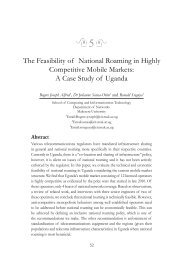Undergraduate Handbook - School of Computing and Informatics ...
Undergraduate Handbook - School of Computing and Informatics ...
Undergraduate Handbook - School of Computing and Informatics ...
Create successful ePaper yourself
Turn your PDF publications into a flip-book with our unique Google optimized e-Paper software.
Reference Books:<br />
i. P. K. Yuen <strong>and</strong> V. Lau, Practical Web Technologies, Addison-Wesley, 2003.<br />
ii. M. Miller, J. Wiley <strong>and</strong> Sons, 501 Web Site Secrets: Unleash the Power <strong>of</strong> Google, Amazon eBay <strong>and</strong><br />
More, 2004.<br />
CSK 1101: Communication Skills (3 CU)<br />
Course Description: This course provides students with skills <strong>of</strong> effective communication. These include verbal,<br />
written, <strong>and</strong> gesture. The course aims at facilitating students appropriately <strong>and</strong> clearly communicate with others. The<br />
aims <strong>of</strong> the course unit are to: Improve the communication competencies <strong>of</strong> the student; Improve problem solving<br />
strategies <strong>of</strong> students; improve the art <strong>of</strong> critical thinking within the student; improve the student’s ability to collect<br />
<strong>and</strong> synthesize information; provide students with knowledge to utilize the library <strong>and</strong> other educational resources.<br />
Indicative Content:<br />
• Writing Skills: Thinking critically/selectively before the writing process; selecting the relevant details;<br />
organising the relevant details logically; writing the reports essays, letters <strong>and</strong> taking notes in appropriate<br />
register; avoiding ambiguities, fallacies, irrationalities; providing supportive evidence; editing documents,<br />
pro<strong>of</strong> reading; writing <strong>and</strong> exp<strong>and</strong>ing information; Quoting <strong>and</strong> citing references; writing a curriculum<br />
vitae.<br />
• Reading Skills: The use <strong>of</strong> skimming; scanning inference <strong>and</strong> prediction in reading; Intensive <strong>and</strong> critical<br />
reading; Acquisition <strong>of</strong> specific reading skills; Interpretation <strong>of</strong> non linear texts; Locating information <strong>and</strong><br />
comprehension.<br />
• Speaking <strong>and</strong> Listening Skills to Enhance Effective Public Relations: The art <strong>of</strong> persuasion in effective<br />
speaking; Conducting interviews; Conducting meetings; Participating in group discussions <strong>and</strong> tutorials;<br />
Non verbal communication clues; Presentation seminars, seeking clarification etc.; Expression <strong>of</strong><br />
politeness; Public speaking; Proper listening skills.<br />
• Examination Skills; Preparing for examinations: How much one gets from group discussions; Proper<br />
revision; Underst<strong>and</strong>ing examination rubric; Budgeting time during examination process; Writing<br />
examinations <strong>and</strong> following instructions<br />
Reference Books:<br />
i. B. Bough, 101 ways to improve your communication skills instantly, 4th edition, 2005.<br />
ii. P. Klavs, The hard Truth About s<strong>of</strong>t skills: Work Place Lessons Smart People wish they had learned sooner,<br />
2008.<br />
BIS 1200 Information Systems in Business (3 CU)<br />
Course Description: The course covers the integration <strong>of</strong> Information <strong>and</strong> Communication Technologies into<br />
organizations <strong>and</strong> their working practices, from design <strong>and</strong> implementation to strategic effects. Drawing on<br />
Information Systems (IS) <strong>and</strong> Management literature, the course <strong>of</strong>fers a chance for students to examine case studies<br />
<strong>of</strong> IS successes <strong>and</strong> failures <strong>and</strong> to explore ’real-world’ IS management issues.<br />
The course aims to provide students with knowledge for underst<strong>and</strong>ing the integration <strong>of</strong> business <strong>and</strong> technology<br />
resources to facilitate effective <strong>and</strong> efficient realization <strong>of</strong> an organization’s mission <strong>and</strong> objectives.<br />
Indicative Content: An information systems model: An Information System uses the resources <strong>of</strong> people,<br />
hardware, s<strong>of</strong>tware, data, <strong>and</strong> networks to perform input, processing, output, storage <strong>and</strong> control activities that<br />
covert data resources into information products; Role <strong>of</strong> Information Systems in an organization; the shift from data<br />
processing Systems via information Systems to knowledge-Based Systems; How information <strong>and</strong> knowledge add<br />
value to an organization; Information Systems Trends; the Information Technology component <strong>of</strong> Information<br />
Systems; Information Systems Engineering. Strategic planning: Organizational strategies <strong>and</strong> objectives; Human<br />
resource development: budgeting, costing, charging, hire versus buy decisions; Hardware <strong>and</strong> s<strong>of</strong>tware procurement:<br />
request for proposal, evaluation, selection,<br />
89

















